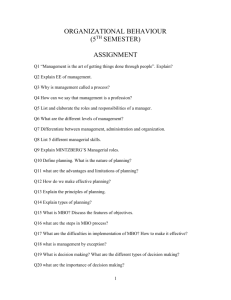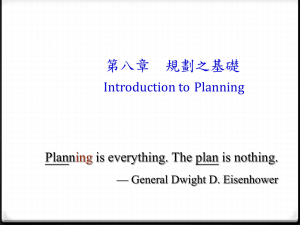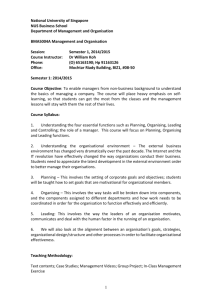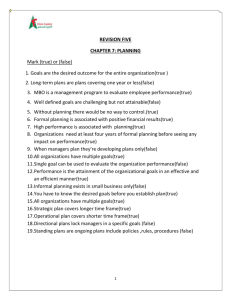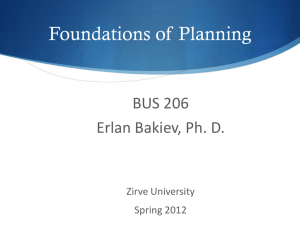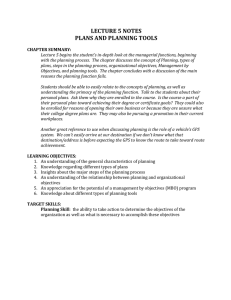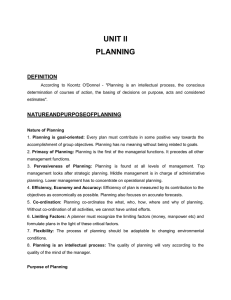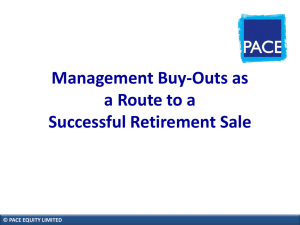UNIT II – PLANNING 1. What is planning? Planning is the process of
advertisement
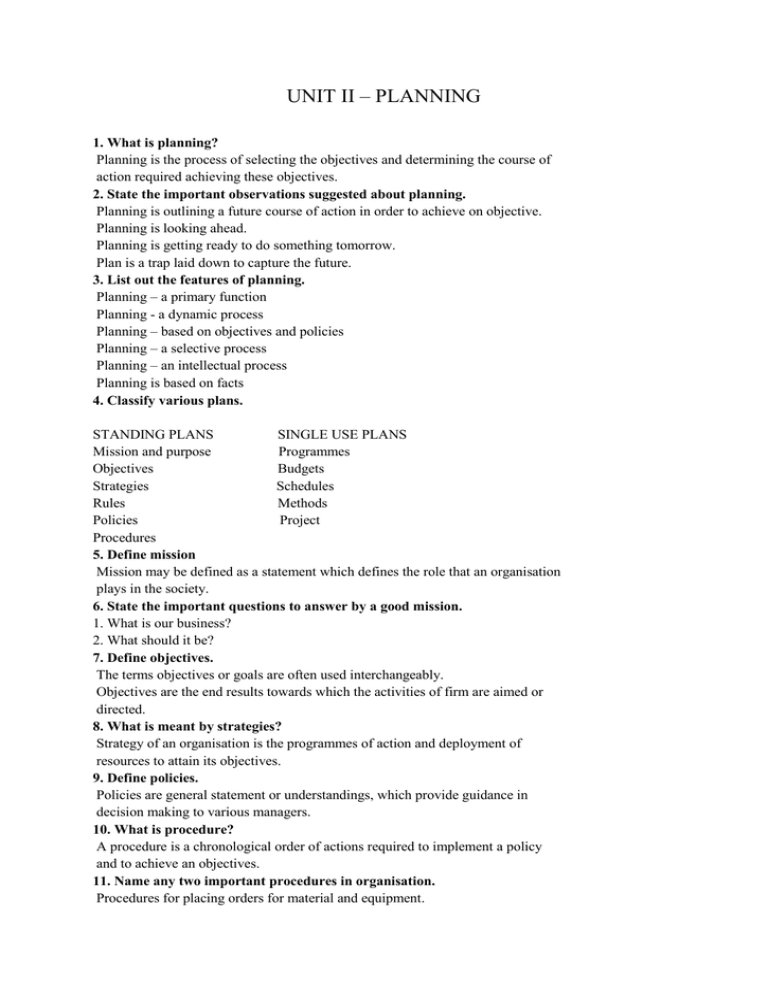
UNIT II – PLANNING 1. What is planning? Planning is the process of selecting the objectives and determining the course of action required achieving these objectives. 2. State the important observations suggested about planning. Planning is outlining a future course of action in order to achieve on objective. Planning is looking ahead. Planning is getting ready to do something tomorrow. Plan is a trap laid down to capture the future. 3. List out the features of planning. Planning – a primary function Planning - a dynamic process Planning – based on objectives and policies Planning – a selective process Planning – an intellectual process Planning is based on facts 4. Classify various plans. STANDING PLANS SINGLE USE PLANS Mission and purpose Programmes Objectives Budgets Strategies Schedules Rules Methods Policies Project Procedures 5. Define mission Mission may be defined as a statement which defines the role that an organisation plays in the society. 6. State the important questions to answer by a good mission. 1. What is our business? 2. What should it be? 7. Define objectives. The terms objectives or goals are often used interchangeably. Objectives are the end results towards which the activities of firm are aimed or directed. 8. What is meant by strategies? Strategy of an organisation is the programmes of action and deployment of resources to attain its objectives. 9. Define policies. Policies are general statement or understandings, which provide guidance in decision making to various managers. 10. What is procedure? A procedure is a chronological order of actions required to implement a policy and to achieve an objectives. 11. Name any two important procedures in organisation. Procedures for placing orders for material and equipment. Procedures for sanctioning different types of employee’s leave. 12. Define budgets. A budget is a statement of expected results in numerical terms and therefore it may be referred as a numerical programme 13. Give the flow diagram of planning steps. Identification Of Opportunities Establishment Of Objectives Developing Planning Premises Identification Of Alternatives Establishment Of Objectives Evaluation Of Alternatives Selecting An Alternatives Formulating Derivative Plans Establishing Sequence Of Activities Identification Of Opportunities 14. What are the advantages and limitations of planning? Advantages • Help in achieving objectives; • Better utilisation of resources; • Economy in operation; • Improves competitive strength Limitations. • Lack of accurate information • Time and cost • Inflexiblity • Delay during emetgency period 15. What is objective? Objectives are the aims, purposes or goals that an organization wants to achieve over varying periods of time. 16. State the two approaches of objectives. i. Top –down approach. ii. Bottom –up approach. 17. What is MBO? MBO is a process whereby, the superior and the subordinate managers of an enterprise jointly identify its common goals, define each individual’s major areas of responsibility in terms of results expected of him, and use these measures as guides for operating the unit and assessing the contribution of its members. 18. Mention the features of MBO. i. MBO focuses attention on what must be accomplished and not how to accomplish the objectives .it is a goal oriented rather than work-oriented approach. ii. MBO tries to combine the long range goals of organisation with short range of organisation. iii. A high degree of motivation and satisfaction is available to employees through MBO. 19. What are the major kinds of strategies and policies? i. Growth. ii. Finance iii. Organisation iv. Personal v. Products or services vi. Market 20. Classify policies. i. Formulated policies ii. Apprealed policy iii. Imposed policy iv. Written policies v. Implied policies 21. What is planning premises? The assumptions about future derived from forecasting and used in planning are known as planning premises. 22. State the classification of planning premises. i. Internal and External. ii. Tangible and intangible iii. Controllable and uncontrollable 23. Define decision-making process. Decision –making is defined as the process of choosing a course of action from among alternatives to achieve a desired goal. It is one of the functions of management and also a core process of planning. 24. What are the techniques useful while evaluating alternatives? i. Quantitative and Qualitative analysis ii. Marginal analysis iii. Cost effectiveness analysis 25. Classify decisions. i. Programmed and non-programmed decisions ii. Organizational and personal decisions
